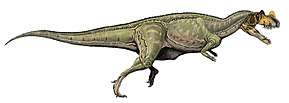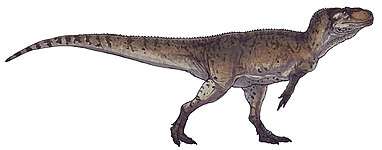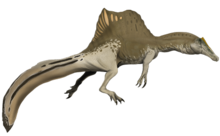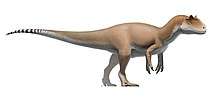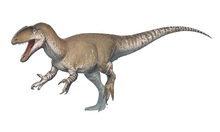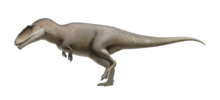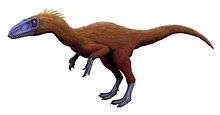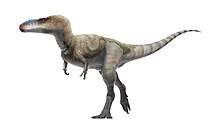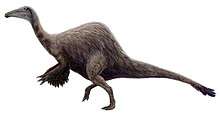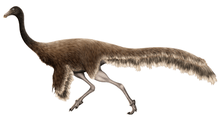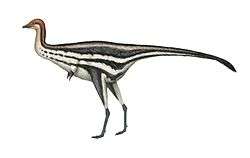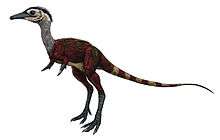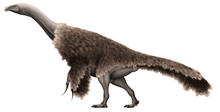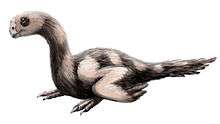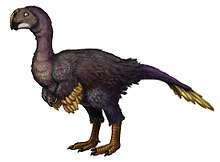Duriavenator
Duriavenator is a genus of theropod dinosaur described in 2008 by Roger Benson; its finds were excavated in England. The only named species in the genus is Duriavenator hesperis, formerly known as Megalosaurus hesperis. Duriavenator lived during the Bajocian stage, around 170 million years ago, making it one of the oldest-known Tetanurae. The genus name combines the Latin name of Dorset, Duria, with Latin for "hunter", venator.[1] This genus has also gone under the unofficial name "Walkersaurus", which is a nomen nudum. It's been estimated to be 7 meters (23 feet) in length.[2]
| Duriavenator | |
|---|---|
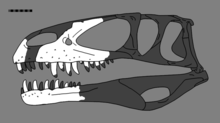 | |
| Reconstruction of the skull with known material shown in white | |
| Scientific classification | |
| Kingdom: | Animalia |
| Phylum: | Chordata |
| Clade: | Dinosauria |
| Clade: | Saurischia |
| Clade: | Theropoda |
| Family: | †Megalosauridae |
| Subfamily: | †Megalosaurinae |
| Genus: | †Duriavenator Benson, 2008 |
| Species: | †D. hesperis |
| Binomial name | |
| †Duriavenator hesperis (Waldman, 1974 [originally Megalosaurus]) | |
| Synonyms | |
| |

Discovery
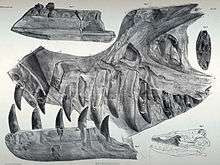
In the Spring of 1882, a friend of contractor Edward Cleminshaw during construction at Redhole Lane in Sherborne, discovered stone blocks with skull remains. The stones had been removed from a quarry at the back of a row of houses at Cold Harbour Road in Greenhill in West Dorset. In 1883, the fossils were by Richard Owen referred to the type species of Megalosaurus, Megalosaurus bucklandii. Owen considered the find especially useful to complete information on the head of Megalosaurus as few of its skull bones had been identified until then.[3]
After 1883, the reference was generally accepted. In 1964 however, Alick Donald Walker concluded that the specimen represented a separate species within the genus Megalosaurus, due to its higher tooth count, but as yet did not name this species.[4]
In 1974, Michael Waldman, in close cooperation with Walker and after further preparation of the fossil, named and described it as a new species of the genus Megalosaurus: Megalosaurus hesperis. The specific name is derived from the Greek Ἑσπερίς, "West" or "western".[5]
The holotype of the species, BNMH R. 332, had been found in a layer, the "freestone", of the Upper Inferior Oolite dating from the late Bajocian, about 168 million years old. It consists of skull and lower jaw parts. It contains both premaxillae, a right maxilla, a possible vomer, both dentaries and a right surangular. Most of the material is present in a main block; a second block had been separated, longitudinally splitting the maxilla.[5]
In the seventies, Samuel Paul Welles and Jaime Emilio Powell prepared a study on European theropods, planning to name a separate genus "Walkersaurus". Their manuscript remained unpublished but in 1994 and 1995 Stephan Pickering divulged parts of it, also containing the name "Walkersaurus hesperis".[6] This is generally considered an invalid nomen nudum or nomen non rite publicatum.
By the early twenty-first century, a consensus had developed that the species was in need of a new genus name. In 2004, the textbook The Dinosauria indicated it as an "unnamed tetanuran".[7]
In 2008, Roger Benson named a separate genus Duriavenator. The generic name is a combination of the Latin Duria, "Dorset", and venator, "hunter". The type species of the genus is Megalosaurus hesperis. The combinatio nova is Duriavenator hesperis.[1]
Classification
The following is a cladogram based on the phylogenetic analysis conducted by Carrano, Benson & Sampson (2012), showing the relationships of Duriavenator:[8]
| Megalosauroidea |
| |||||||||||||||||||||||||||||||||||||||||||||||||||||||||||||||
References
- Benson, R.B.J. (2008). "A redescription of "Megalosaurus" hesperis (Dinosauria, Theropoda) from the Inferior Oolite (Bajocian, Middle Jurassic) of Dorset, United Kingdom". Zootaxa 1931: 57-67.
- Holtz, Thomas R. (2012). "Dinosaurs: The Most Complete, Up-to-Date Encyclopedia for Dinosaur Lovers of All Ages" (PDF).
- Owen, R., 1883. "On the skull of Megalosaurus". Quarterly Journal of the Geological Society of London 39(1-4): 334-347
- Walker, A.D. 1964. "Triassic reptiles from the Elgin area: Ornithosuchus and the origin of carnosaurs". Philosophical Transactions of the Royal Society of London B, 244: 53–134
- Waldman, M. (1974). "Megalosaurids from the Bajocian (Middle Jurassic) of Dorset" (PDF). Palaeontology. 17 (2): 325–339.
- Pickering, S., 1995. "Jurassic Park: Unauthorized Jewish Fractals in Philopatry" in: A Fractal Scaling in Dinosaurology Project, 2nd revised printing, Capitola, California
- Weishampel, D.B. e.a., 2004, The Dinosauria, Berkeley, Los Angeles, London: University of California Press, p. 72
- Carrano, M. T.; Benson, R. B. J.; Sampson, S. D. (2012). "The phylogeny of Tetanurae (Dinosauria: Theropoda)". Journal of Systematic Palaeontology 10 (2): 211–300. doi:10.1080/14772019.2011.630927
